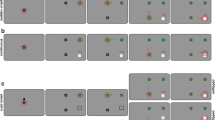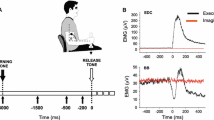Abstract
The control of eye movements depends in part on subcortical motor centres. Gaze is often directed towards salient visual stimuli of our environment with no conscious voluntary commands. To further understand to what extent preprogrammed eye movements can be triggered subcortically, we carried out a study in normal volunteers to examine the effects of a startling auditory stimulus (SAS) on externally guided saccades. A peripheral visual cue was presented in the horizontal plane at a site distant 15° from the fixation point, and subjects were instructed to make a saccade to it. SAS was presented together with the peripheral visual cue in 20% of trials. To force rapid visual fixation at the end of the saccade, targets were loaded with a second cue, a small arrow pointing towards the right or the left (or a neutral sign), not distinguishable with peripheral vision. Subjects were requested to perform a flexion/extension wrist movement, according to the direction of the arrow (or not to move if the second cue was the neutral sign). SAS presented together with the visual target caused a significant shortening of the latency of saccadic movements. The wrist movements performed as a response to the second cue had similar reaction times regardless of whether the trial contained a SAS or not. Our results show that voluntary saccades to peripheral targets are speeded up by activation of the startle circuit, and that this effect does not cause a significant disturbance in the execution of simple in-target cues. These results suggest that subcortical structures play a main role in preparation of externally guided saccades.


Similar content being viewed by others
References
Behan M, Appell PP (1992) Intrinsic circuitry in the cat superior colliculus: projections from the superficial layers. J Comp Neurol 315:230–243
Bell AH, Meredith MA, Van Opstal AJ, Munoz DP (2005) Crossmodal integration in the primate superior colliculus underlying the preparation and initiation of saccadic eye movements. J Neurophysiol 93:3659–3673
Blumenthal TD, Cuthbert BN, Filion DL, Hackley S, Lipp OV, Van Boxtel A (2005) Committee report: guidelines for human startle eyeblink electromyographic studies. Psychophysiology 42:1–15
Boulinguez P, Blouin J, Nougier V (2001) The gap effect for eye and hand movements in double-step pointing. Exp Brain Res 138:352–358
Bour LJ, Aramideh M, Ongerboer DE, Visser BW (2000) Neurophysiological aspects of eye and eyelid movements during blinking in humans. J Neurophysiol 83:166–176
Brown P, Rothwell JC, Thompson PD, Britton TC, Day BL, Marsden CD (1991a) New observations on the normal auditory startle reflex in man. Brain 114:1891–1902
Brown P, Day BL, Rothwell JC, Thompson PD, Marsden CD (1991b) The effect of posture on the normal and pathological auditory startle reflex. J Neurol Neurosurg Psychiatry 54:892–897
Carlsen AN, Hunt MA, Inglis JT, Sanderson DJ, Chua R (2003) Altered triggering of a prepared movement by a startling stimulus. J Neurophysiol 89:1857–1863
Carlsen AN, Chua R, Inglis JT, Sanderson DJ, Franks IM (2004) Prepared movements are elicited early by startle. J Motor Behav 36:253–264
Chokroverty S, Walczak T, Hening W (1992) Human startle reflex: technique and criteria for abnormal response. Electroencephalogr Clin Neurophysiol 85:236–242
Collewijn H, Van Der Steen J, Steinman RM (1985) Human eye movements associated with blinks and prolonged eye closure. J Neurophysiol 54:11–27
Coubard O, Daunys G, Kapoula Z (2004) Gap effects on saccade and vergence latency. Exp Brain Res 154:368–381
Davis M, Gendelman DS, Tishler MD, Gendelman PM (1982) A primary acoustic startle circuit: lesion and stimulation studies. J Neurosci 2:791–805
Doubell TP, Skaliora I, Baron J, King AJ (2003) Functional connectivity between the superficial and deeper layers of the superior colliculus: an anatomical substrate for sensorimotor integration. J Neurosci 23:6596–6607
Evinger C, Shaw MD, Peck CK, Manning KA, Baker K (1984) Blinking and associated eye movements in human, guinea pig and rabbits. J Neurophysiol 52:323–329
Fawcett AP, Dostrovsky JO, Lozano AM, Hutchison WD (2005) Eye movement-related responses of neurons in human subthalamic nucleus. Exp Brain Res 162:357–365
Flaten MA, Nordmark E, Elden A (2005) Effects of background noise on the human startle reflex and prepulse inhibition. Psychophysiology 42:298–305
Frith CD, Done DJ (1986) Routes to action in reaction time tasks. Psychol Res 48:169–177
Gandhi NJ, Bonadonna DK (2005) Temporal interactions of air-puff-evoked blinks and saccadic eye movements: insights into motor preparation. J Neurophysiol 93:1718–1729
Gehricke JG, Ornitz EM, Siddarth P (2002) Differentiating between reflex and spontaneous blinks using simultaneous recording of the orbicularis oculi electromyogram and the electro-oculogram in startle research. Int J Psychophysiol 44:261–268
Gnadt JW, Lu SM, Breznen B, Basso MA, Henriquez VM, Evinger C (1997) Influence of the superior colliculus on the primate blink reflex. Exp Brain Res 116:389–398
Goossens HH, Van Opstal AJ (2000) Blink-perturbed saccades in monkey. I. Behavioral analysis. J Neurophysiol 83:3411–3429
Gribble PL, Everling S, Ford K, Mattar A (2002) Hand-eye coordination for rapid pointing movements. Arm movement direction and distance are specified prior to saccade onset. Exp Brain Res 145:372–382
Heide W, Koenig E, Trillenberg P, Kömpf D, Zee DS (1999) Electrooculography: technical standards and applications. Electroencephalogr Clin Neurophysiol Suppl 52:223–240
Henderson L, Dittrich WH (1998) Preparing to react in the absence of uncertainty: I. New perspectives on simple reaction time. Br J Psychol 89:531–554
Hikosaka O, Takikawa Y, Kawagoe R (2000) Role of the basal ganglia in the control of purposive saccadic eye movements. Physiol Rev 80:953–978
Horn AK, Buttner-Ennever JA, Suzuki Y, Henn V (1995) Histological identification of premotor neurons for horizontal saccades in monkey and man by parvalbumin immunostaining. J Comp Neurol 359:350–363
Isa T (2002) Intrinsic processing in the mammalian superior colliculus. Curr Opin Neurobiol 12:668–677
Isa T, Naito K (1995) Activity of neurons in the medial pontomedullary reticular formation during orienting movements in alert head-free cats. J Neurophysiol 74:73–95
Kofler M, Muller J, Reggiani L, Valls-Sole J (2001a) Influence of gender on auditory startle responses. Brain Res 921:206–210
Kofler M, Muller J, Reggiani L, Valls-Sole J (2001b) Influence of age on auditory startle responses in humans. Neurosci Lett 307:65–68
Kumru H, Valls-Sole J (2006) Excitability of the pathways mediating the startle reaction before execution of a voluntary movement. Exp Brain Res 169:427–432
Kumru H, Urra X, Compta Y, Castellote JM, Turbau J, Valls-Sole J (2006) Excitability of subcortical motor circuits in Go/noGo and forced choice reaction time tasks. Neurosci Lett (in press)
Landis C, Hunt WA (1939) The startle pattern. Farrar and Rinehart, New York
Lee PH, Helms MC, Augustine GJ, Hall WC (1997) Role of intrinsic synaptic circuitry in collicular sensorimotor integration. Proc Natl Acad Sci USA 94:13299–13304
Leintner DS, Powers AS, Hoffman HS (1980) The neural substrate of the startle response. Physiol Behav 25:291–297
Matsumura M, Kojima J, Gardiner TW, Hikosaka O (1992) Visual and oculomotor functions of monkey subthalamic nucleus. J Neurophysiol 67:1615–1632
Moschovakis AK (1996) The superior colliculus and eye movement control. Curr Opin Neurobiol 6:811–816
Munoz DP, Fecteau JH (2002) Vying for dominance: dynamic interactions control visual fixation and saccadic initiation in the superior colliculus. Prog Brain Res 140:3–19
Munoz DP, Istvan PJ (1998) Lateral inhibitory interactions in the intermediate layers of the monkey superior colliculus. J Neurophysiol 79:1193–1209
Munoz DP, Wurtz RH (1993) Fixation cells in monkey superior colliculus. I. Characteristics of cell discharge. J Neurophysiol 70:559–575
Nieuwenhuijzen PH, Schillings AM, Van Galen GP, Duysens J (2000) Modulation of the startle response during human gait. J Neurophysiol 84:65–74
Petit L, Tzourio N, Orssaud C, Pietrzyk U, Berthoz A, Mazoyer B (1995) Functional neuroanatomy of the human visual fixation system. Eur J Neurosci 7:169–174
Pierrot-Deseilligny C, Rivaud S, Gaymard B, Muri R, Vermersch AI (1995) Cortical control of saccades. Ann Neurol 37:557–567
Priori A, Berardelli A, Rothwell JC, Day BL, Marsden CD (1993) Some saccadic eye movements can be delayed by transcranial magnetic stimulation of the cerebral cortex in man. Brain 116:355–367
Rambold H, Sprenger A, Helmchen C (2002) Effects of voluntary blinks on saccades, vergence eye movements, and saccade-vergence interactions in humans. J Neurophysiol 88:1220–1233
Rambold H, El Baz I, Helmchen C (2005) Effect of blinks on saccades before smooth-pursuit eye-movement initiation. Ann NY Acad Sci 1039:563–566
Rottach KG, Das VE, Wohlgemuth W, Zivotofsky AZ, Leigh RJ (1998) Properties of horizontal saccades accompanied by blinks. J Neurophysiol 79:2895–2902
Smit AE, Zerari-Mailly F, Buisseret P, Buisseret-Delmas C, Vanderwerf F (2005) Reticulo-collicular projections: a neuronal tracing study in the rat. Neurosci Lett 380:276–279
Sommer MA, Wurtz RH (2000) Composition and topographic organization of signals sent from the frontal eye field to the superior colliculus. J Neurophysiol 83:1979–2001
Sparks D, Rohrer WH, Zhang Y (2000) The role of the superior colliculus in saccade initiation: a study of express saccades and the gap effect. Vision Res 40:2763–2777
Valls-Sole J, Rothwell JC, Goulart F, Cossu G, Munoz E (1999) Patterned ballistic movements triggered by a startle in healthy humans. J Physiol 516:931–938
Valls-Sole J (2004) Contribution of subcortical motor pathways to the execution of ballistic movements. Suppl Clin Neurophysiol 57:554–562
Wilkins DE, Hallett M, Wess MM (1986) Audiogenic startle reflex of man and its relationship to startle syndromes. A review. Brain 109:561–573
Yeomans JS, Li L, Scott BW, Frankland PW (2002) Tactile, acoustic and vestibular systems sum to elicit the startle reflex. Neurosci Biobehav Rev 26:1–11
Zhao Z, Davis M (2004) Fear-potentiated startle in rats is mediated by neurons in the deep layers of the superior colliculus/deep mesencephalic nucleus of the rostral midbrain through the glutamate non-NMDA receptors. J Neurosci 24:10326–10334
Author information
Authors and Affiliations
Corresponding author
Rights and permissions
About this article
Cite this article
Castellote, J.M., Kumru, H., Queralt, A. et al. A startle speeds up the execution of externally guided saccades. Exp Brain Res 177, 129–136 (2007). https://doi.org/10.1007/s00221-006-0659-4
Received:
Accepted:
Published:
Issue Date:
DOI: https://doi.org/10.1007/s00221-006-0659-4




